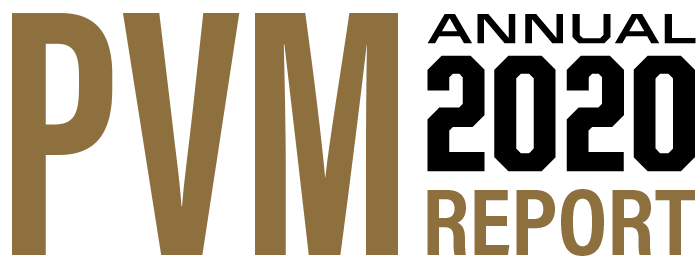Veterinary Medicine Adapts to Safely Deliver Vital In-person Instruction
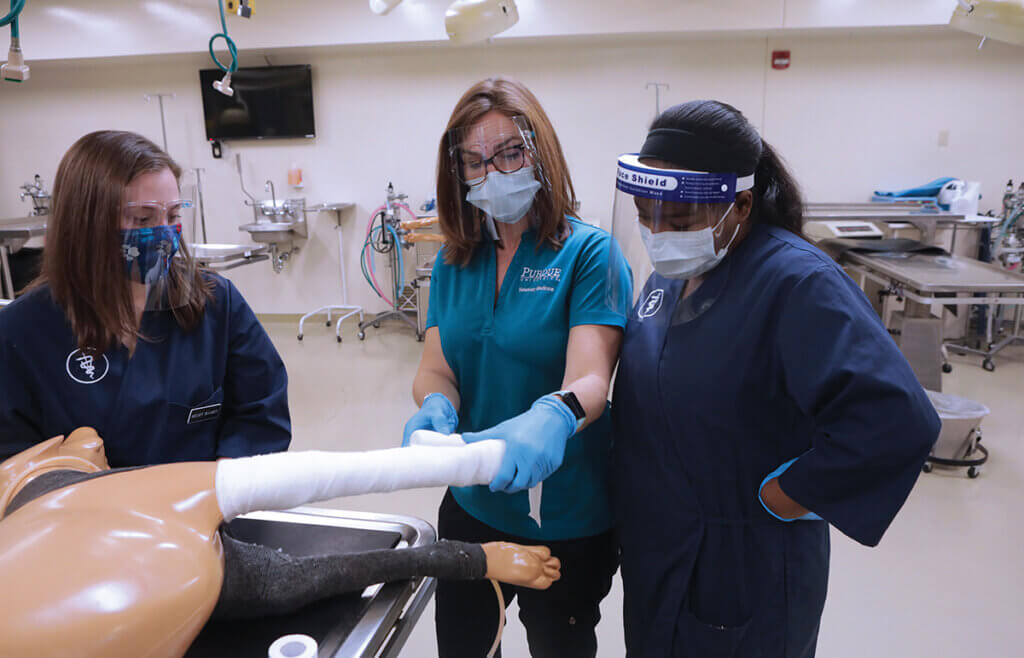
Protect Purdue
As with so many aspects of the year 2020, “Back to School” took on a whole new meaning for Purdue University College of Veterinary Medicine students, faculty, and staff as a new semester began in August. DVM and Veterinary Nursing students were among the more than 41,000 students who came back to the Purdue campus for in-person instruction —discontinued since March when the raging COVID-19 pandemic necessitated a sudden switch to online instruction and students were sent home.
Greeted by large banners on buildings displaying the words “Protecting the Next Giant Leap,” students, as well as faculty and staff, stepped back into classes on August 24, after fourth-year DVM students had come back for clinical rotations on July 20. Their return to campus followed a summer of careful planning that led to implementation of the Protect Purdue Plan, which was developed as a result of the initial work of the Safe Campus Task Force co-chaired by Purdue Veterinary Medicine Dean Willie Reed and the dean of the Krannert School of Management David Hummels.
The plan included a pledge taken by all students, staff, and faculty — summarized by the words “Protect Myself. Protect Others. Protect Purdue.” Utilizing the latest guidance from the Centers for Disease Control and Prevention (CDC), the Indiana State Department of Health and other scientific organizations, the University implemented the Protect Purdue Plan as a comprehensive strategy to keep the campus and community safe by limiting the spread of COVID-19.
Practical Solutions
For the College of Veterinary Medicine, following the Protect Purdue Plan meant de-densifying teaching spaces to limit seating capacity by 50 percent and re-working the “traditional” course schedule to use the college’s largest lecture hall for DVM courses and smaller lecture rooms for Veterinary Nursing courses. “That enabled us to teach each of the student class cohorts in their entirety in the respective rooms,” explained Dr. Jim Weisman, assistant dean for student affairs and clinical associate professor.
Changes in the lecture halls were readily visible to anyone familiar with pre-COVID life in Lynn Hall. Most notably – everyone, from teachers to students, wore masks and students were spaced apart with seats alternately marked as available or not available due to social distancing requirements. Additionally, students were instructed to clean their desk space upon entry and departure from each classroom. “We also established seating charts for the lecture halls and asked students to sit in their self-selected seats for the duration of the semester,” Dr. Weisman explained. Moreover, no eating or drinking was allowed during any class session and, in addition to wearing masks during all lecture-based courses, students and instructors also wore face shields for labs where they worked more closely together.
With these measures in place, students once again were able to learn in-person instead of just virtually. “We returned all of our DVM and Veterinary Nursing courses to face-to-face instruction,” Dr. Weisman said. “The key difference for the DVM curriculum is that we arranged for part of the traditionally scheduled lecture time to be face-to-face, with the remaining contact time offered either via lectures that were pre-recorded and available on Brightspace, the University’s learning management system, or by utilizing videoconferencing platforms, such as Zoom, to provide remote, live interactive class sessions,” Dr. Weisman said. Additionally, all labs were scheduled face-to-face.
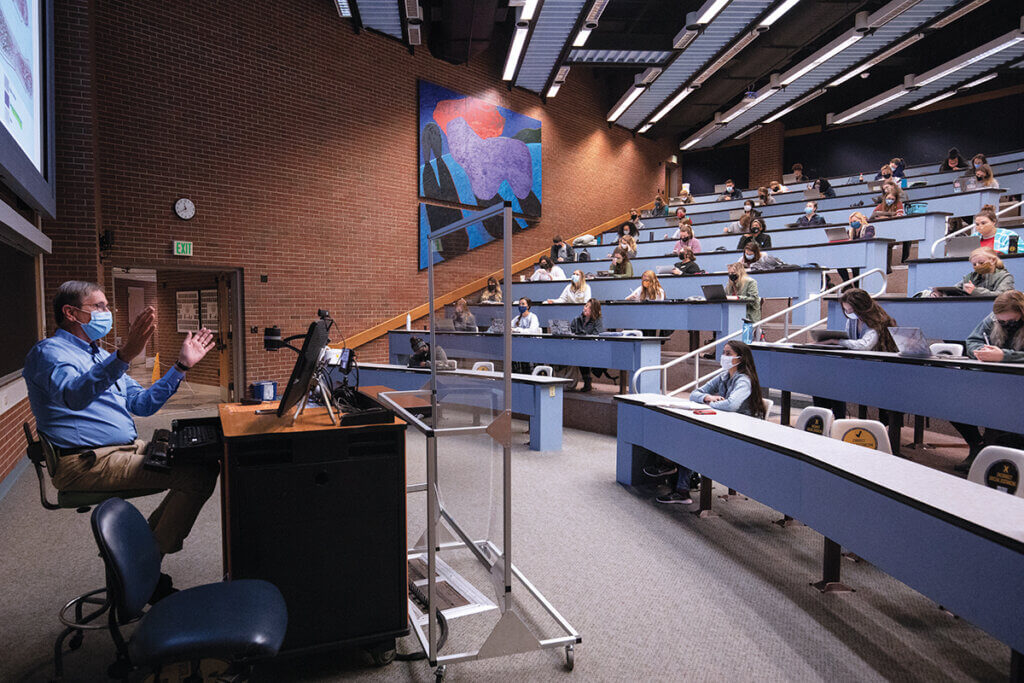
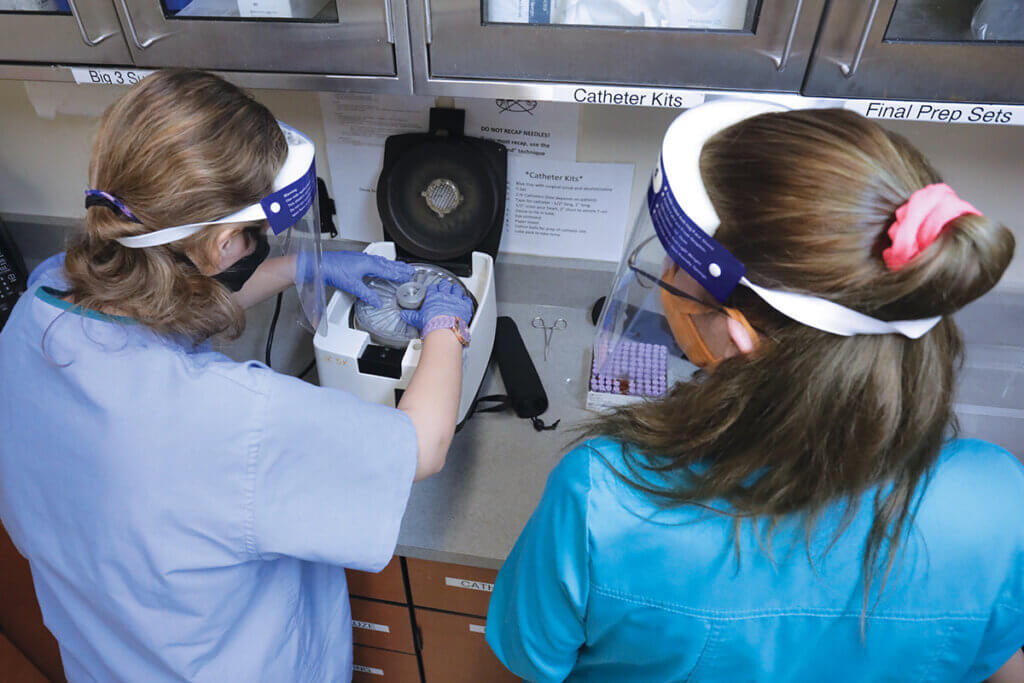
Any students who could not attend in-person classes were able to watch them on Brightspace, since all courses were lecture-captured, a practice the college had put in place previously. “We have traditionally recorded lectures and students have used this in the past to go back and re-watch lectures,” Dr. Weisman explained.
We Keep Going
The college’s success in adapting to in-person instruction during the pandemic mattered for multiple reasons. “For most of our DVM students, they want this face-to-face instruction and contact with their instructors,” explained Dr. Weisman. “For our lab-based instruction, hands-on learning is required to develop the competencies of these skills, thus face-to-face is the best option for this.”
Those sentiments were echoed by Dr. Chad Brown, director of the Veterinary Nursing Program. “Hands-on laboratory instruction is required as part of accreditation,” Dr. Brown said. “The biggest thing I’ve been impressed with is the way Purdue has handled this whole situation, and kept our college open. That’s a big deal. I am incredibly appreciative of the initiative and effort to follow the protocols to keep us face-to-face. It’s commendable and admirable how everyone is doing.”
Students concurred. “We have been very fortunate to still attend in-person classes,” said Debby Key, a fourth-year student in the Veterinary Nursing bachelor’s degree program. “Aside from the masks and socially distanced seating, the actual class atmosphere has not felt much different from a ‘normal’ semester. For the size of our program, the precautions taken seemed to work well and were smoothly implemented.”
Fellow classmate, Bayli Grubb, agreed. “I think even though we had to sit six-feet apart and wear masks, it was still beneficial to be in the classroom learning,” Bayli said. “It has been a privilege to have the opportunity to come back and finish the Veterinary Nursing Program in person. It would be very difficult to achieve this solely online.”
Dr. Brown added that there were minimal problems with re-introducing face-to-face instruction. The main issue involved setting expectations and ensuring follow-through. As for teaching, the only real difference was wearing a mask and face shield when instructing. “Not surprisingly, some of the challenges relayed to me by our instructors was that they had to speak really loudly and experienced some initial awkwardness delivering hands-on instruction while wearing more PPE than they were used to,” Dr. Brown said. “But all of them were able to quickly adjust and make sure that our nursing students still received a top-notch educational experience.”
Emily Hess, a DVM student in the Class of 2022 and president of the Purdue Student Chapter of the American Association of Equine Practitioners, said she feels very fortunate to have been able to return to in-person instruction for the fall semester. “It has been instrumental to be able to participate in our Veterinary Skills and Competencies and Junior Surgery courses, as well as to interact with our professors face-to-face,” Emily said. “It also has been exciting to be able to host a few, socially distanced, student organization events. For example, the Equine Club was able to host in-person rounds in the Large Animal Hospital.”
Emily’s classmate Cameron Seger said he appreciated the concern for the health of students, faculty, and staff. “Transitioning to the schedule we had this semester, I felt that my health and the health of other students was kept as priority,” Cameron said. “I also felt that I was given good opportunities to carry out in-person skills. As everyone knows, this is a profession of skills and communication. Sacrificing these opportunities would be detrimental to our ability to develop into capable practitioners. Knowing this, and being able to keep a hold on these experiences through a troubling time is quite valuable.”
First-year veterinary student Joe Chandler described himself as someone who learns best from face-to-face instruction. “Hands on training is so crucial in our career development and being able to have that from the beginning was awesome,” Joe said. He also noted all the care that was taken to disinfect. “One thing that really stood out to me was the extra cleaning that was done by the staff – door handles being wiped down, cleaning supplies always stocked, and high touch surfaces always being cleaned. This really stood out to me in the College of Veterinary Medicine.”
Fellow classmate Jessica Sexton noted, “It took a few labs to figure out how to prevent face shields from fogging up!” But, she said it was well worth it because the in-person classes enabled her to experience something that impressed her when she first visited Lynn Hall back at the beginning of 2020 as part of the admissions process. “On interview day, I got to experience how connected the other classes were, which really gave the school a sense of community. This was a major factor in my decision to attend Purdue, as I really wanted to build that connection with my classmates,” Jessica said. “This was important to me not only to build lasting friendships, but to have many professional relationships with my future colleagues. After my first semester of vet school I can honestly say that I have created an awesome network of friends and colleagues that I know will be a support system throughout vet school and our future careers! And this is all because of being able to return in person.”
Students also commended Purdue for its contact-tracing program and free COVID-19 testing for students, staff, and faculty. Jessica said the combination of contact tracing and surveillance testing made her feel safer in classes and in labs. Veterinary Nursing student Debby Key added that the ease and availability of the COVID-19 testing “…was vital to identifying positive cases and allowing us to maintain in-person instruction for as long as we did.”
One downside, noted by Joe Chandler, was the revised academic calendar that kept the students on campus straight-through to Thanksgiving, without the traditional Labor Day holiday and Fall Break – a condensed schedule that Joe realized was mentally very exhausting and taxing. After November 24, face-to-face instruction ended, except for fourth-year clinical education, and students left for home. The remaining classes in December were delivered virtually, as were final exams.
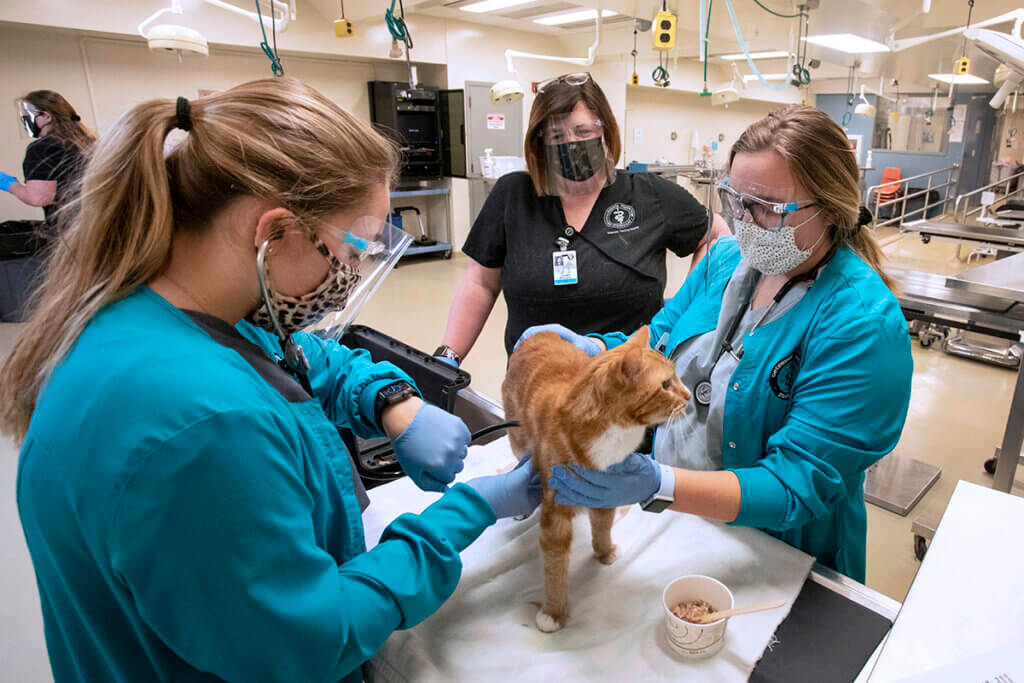
Our Persistent Pursuit
Looking ahead to spring, with the start of the spring semester scheduled in mid-January, Dr. Weisman said the college plans a similar approach to that used in the fall for in-person course lecture time and face-to-face lab instruction. He also noted that the spring semester will be the final semester for the rollout of the revised DVM curriculum, with semester six being offered for the first time.
Speaking from the students’ perspective, third-year veterinary student Emily Hess encouraged everyone to continue their hard work and perseverance through these difficult times. “I believe that we can continue to look for ways to work as a team, in order to make the best of our current situation,” Emily said. “I think that the ability to be flexible and resilient goes a long way. Lastly, I would like to thank each of our professors and instructors, no matter what year of the DVM or Veterinary Nursing Program they teach, for their continued hard work and dedication this semester.”
Reflecting on the unprecedented changes that occurred in the fall, Dr. Weisman remarked, “Our success in our delivery of the curricula was based on everyone’s attention and willingness to adapt to Protect Purdue guidelines. It was and continues to be a Herculean effort by everyone and, as a result, our programs have continued to offer the great instruction and experiential learning our students have known to be our standard.”

